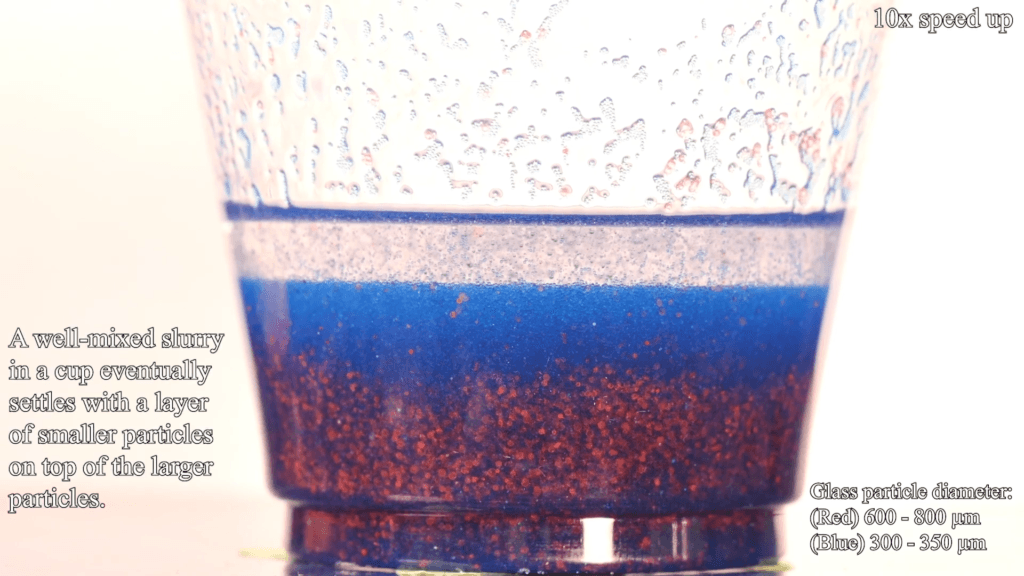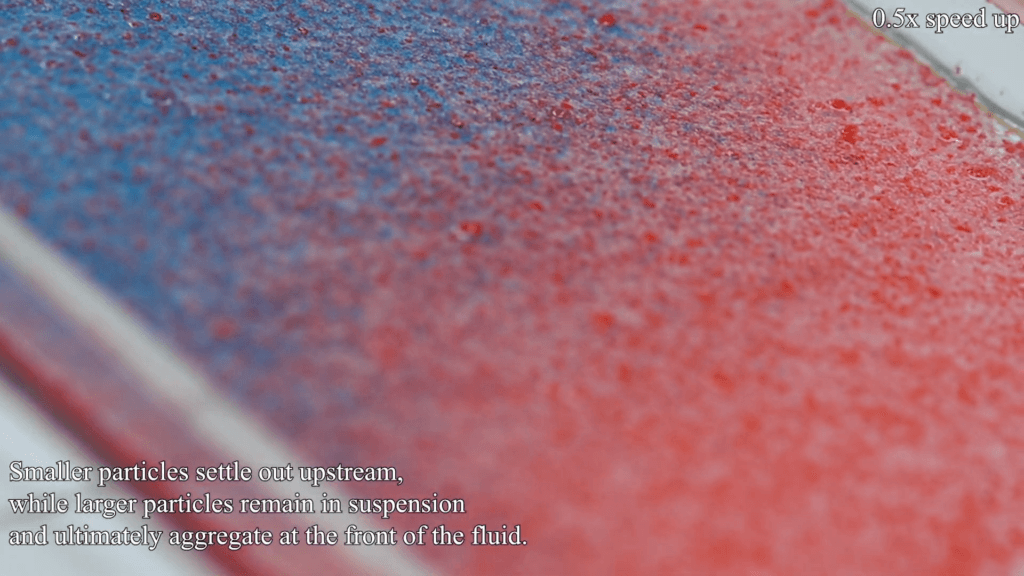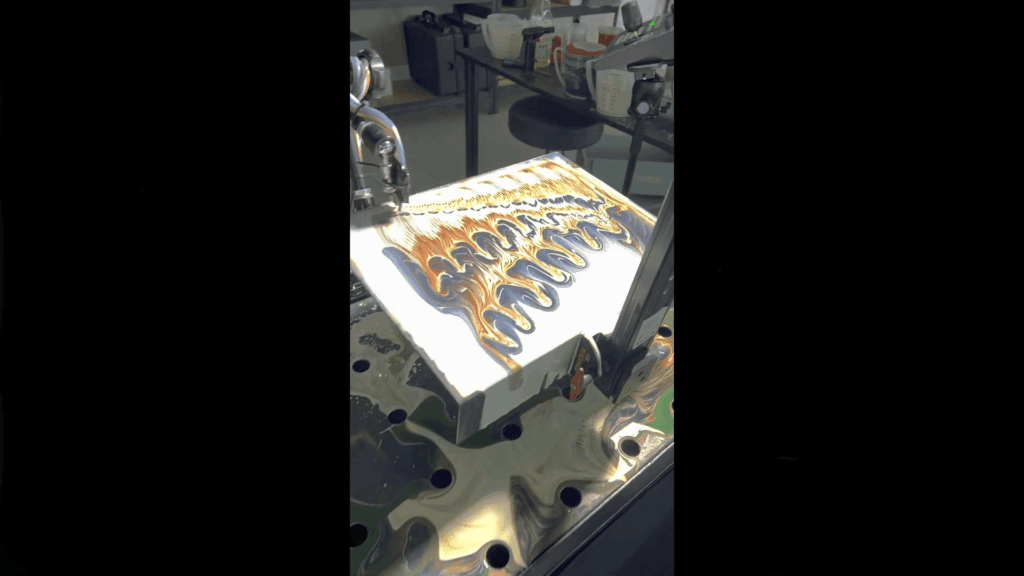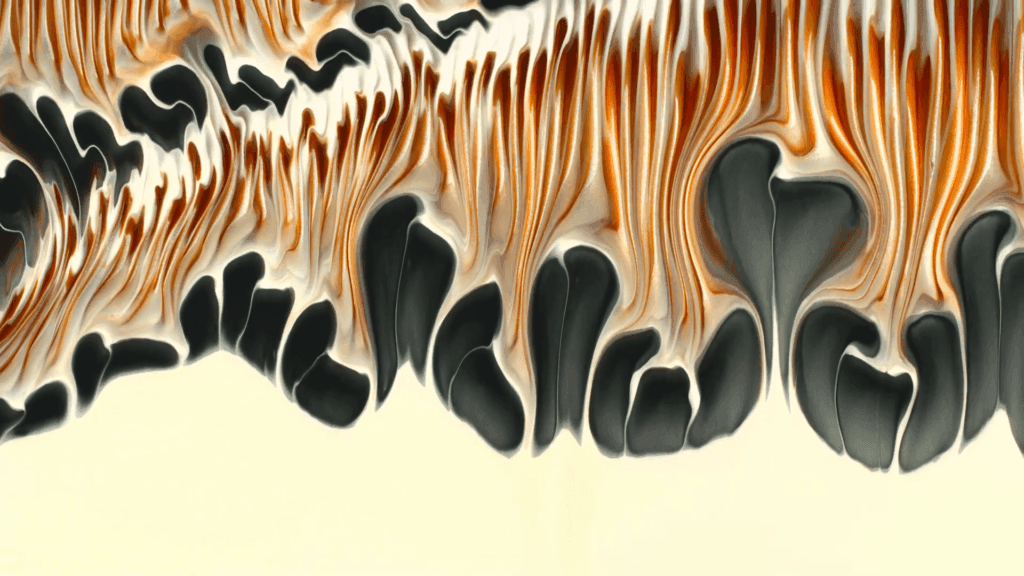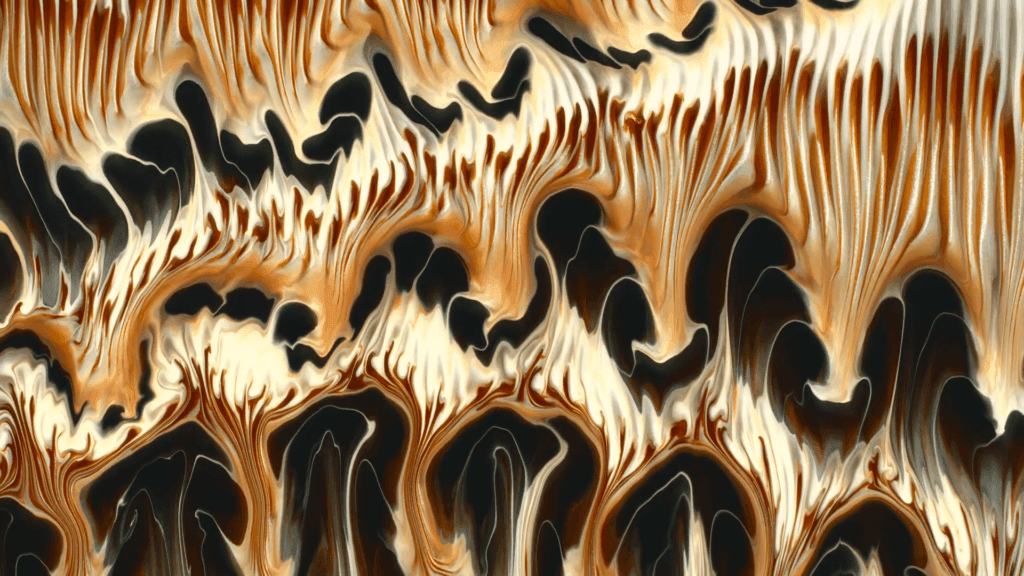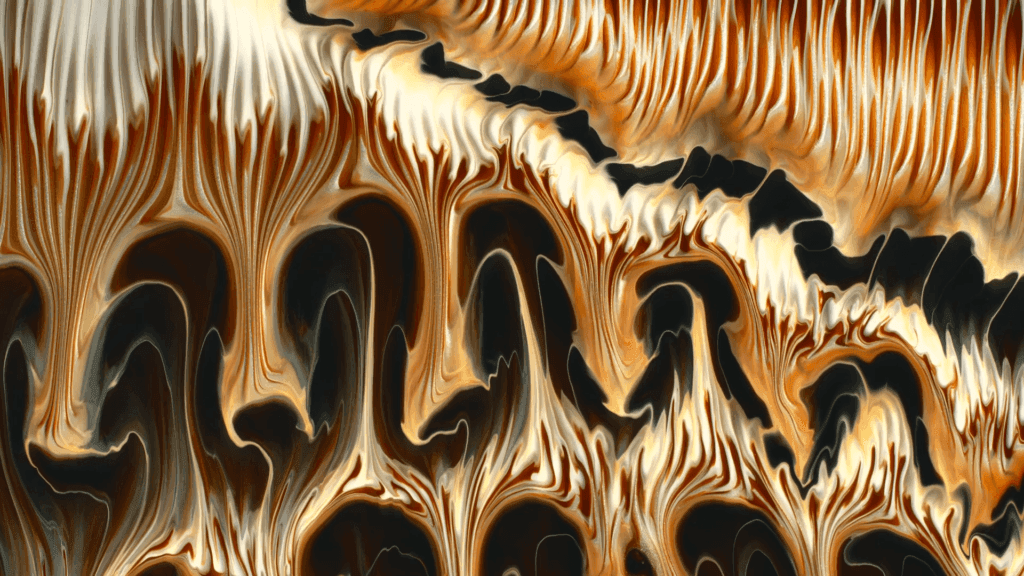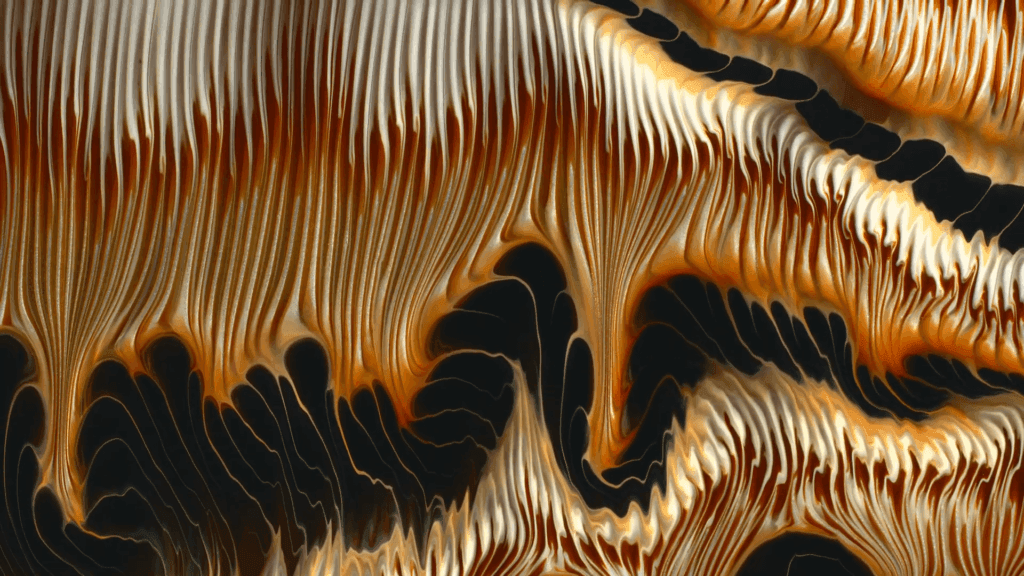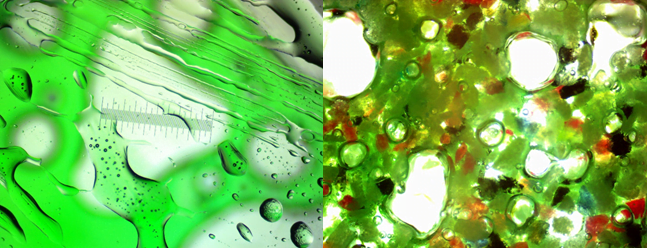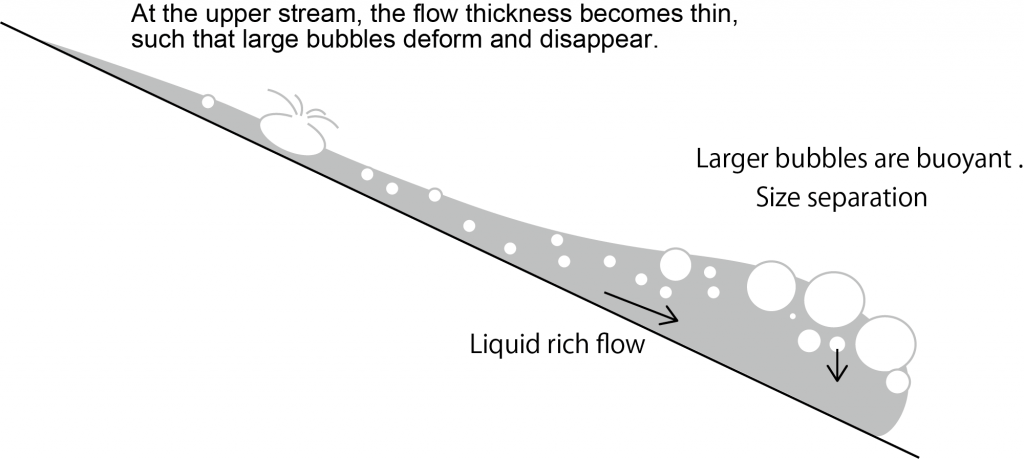Mudslides and avalanches typically carry debris of many shapes and sizes. To understand how debris size affects flows like these, researchers use simplified, laboratory-scale experiments like this one. Here, researchers mix a slurry of silicone oil and glass particles of roughly two sizes. The red particles are larger; the blue ones smaller. Sitting in a cup, the mixture tends to separate, with red particles sinking faster to form the bottom layer and smaller blue particles collecting on top. And what happens when such a mixture flows down an incline? The smaller blue particles tend to settle out sooner, leaving the larger red particles in suspension as they flow downstream. (Video and image credit: S. Burnett et al.)
Tag: gravity current

Reclaiming the Land
Lava floods human-made infrastructure on Iceland’s Reykjanes peninsula in this aerial image from photographer Ael Kermarec. Protecting roads and buildings from lava flows is a formidable challenge, but it’s one that researchers are tackling. But the larger and faster the lava flow, the harder infrastructure is to protect. Sometimes our best efforts are simply overwhelmed by nature’s power. (Image credit: A. Kermarec/WNPA; via Colossal)

“One”
A 4-minute, unedited one-shot video of colorful paint sliding down a sheet? Yes, please.
Beautiful visuals aside, there are some really interesting physics involved here. It’s unclear whether the there’s any change in the speed at which paint gets deposited at the top of the incline over the course of the video, yet we see huge changes in the visual patterns. This happens, in part, because the layer of paint is getting thicker and heavier over time, changing the dynamics of its slide under gravity. There may even be some shear-thinning going on, given that paint is usually non-Newtonian. I can imagine some connections to landslides, avalanches, and other gravity currents with non-Newtonian fluids. (Video and image credit: R. De Giuli)

“Emitter”
For this latest experimental film, artist Roman De Giuli provides a glimpse of the unique fluid art machine he’s built over the last 3.5 years. With 10 channels driven by peristasltic tube pumps and stepper motors, his “printer” drips up to 10 colors on a paint-covered, tilted canvas to create these beautiful images. As he says in his description of the invention, the set-up produces paint layering that’s almost impossible to create by hand. Fluid dynamically speaking, we’re seeing gravity currents like a lava flow or avalanche that are mixing together viscously. There’s also some added effects from density differences between different layered paint colors. Artistically, this machine offers an infinite palette of visual opportunities; financially, though, De Giuli admits its an absolute beast at consuming paint! (Image and video credit: R. De Giuli)

Underwater Volcanic Flows
The Hunga Tonga–Hunga Ha’apai volcanic eruption in December 2021 was the most violent in 140 years, and we are still learning from its aftermath. A recent study focuses on the eruption’s incredible underwater flows, which damaged nearly 200 kilometers of underwater cables. From the cables’ locations and the time of service loss, the team calculated that gravity currents hit the cables at speeds as high as 122 kilometers per hour and with run-outs that lasted over 100 kilometers. These fast flows were triggered by material from the volcanic plume falling into the ocean, causing dense flows that swept down the submerged slopes of the volcano and seafloor.

Illustration of volcanic plume material falling into the ocean and triggering underwater flows. Previously, a landslide broke underwater telegraph cables off Newfoundland and a coastal construction accident severed a cable in the Mediterranean. But neither of those incidents revealed the same level of speed, distance, and destructive capacity as the Tongan eruption. It seems that these underwater gravity currents pose an ongoing threat to submerged infrastructure. As more cables are laid in volcanically-active regions of the Pacific, we will need more extensive mapping and monitoring of the seafloor to protect against future disruptions. (Image credit: eruption – Tonga Geological Services, illustration – APS/C. Cain; research credit: M. Clare et al.; via APS Physics)

Kelvin-Helmholtz Flows Downhill
Gravity currents carry denser fluids into lighter ones, like cold air drifting under your door in winter or dense fogs flowing downhill in San Francisco. Here, researchers visualize the situation using denser salt water flowing into fresh water. Once the gate separating the two fluids rises, the salt water slides down an artificial slope into the fresh water.
Very quickly the flow forms a Kelvin-Helmholtz instability due to the different flow speeds between the two fluids. Kelvin-Helmholtz waves form distinctive swirls and billows that are reminiscent of a cat’s eye. As the swirls rotate, they can flow over one another, and break up into turbulence. (Image and video credit: C. Troy and J. Koseff)

Bubbles Affect Lava Flow
During the 2018 eruption at Kilauea, scientists noticed that the lava flowed very differently depending on how bubbly it was. In this experiment, researchers used corn syrup as a lava analogue and studied how bubbly and particle-filled bubbly flows differed from bubble-free ones. They found that bubble-free syrup flowed fastest, while particle-filled bubbly flows were by far the slowest.
The bubbles also affected the structure of the flows. Large bubbles gathered near the surface of the flow’s leading edge, allowing faster flow beneath. And in the particle-filled flow, the corn syrup developed channels that flowed at different speeds. The authors hope that their relatively simple experimental set-up will inspire more research on bubbly lava flows. (Image and research credit: A. Namiki et al.; via AGU Eos; submitted by Kam-Yung Soh)

Recreating Pyroclastic Flow
One of the deadliest features of some volcanic eruptions is the pyroclastic flow, a current of hot gas and volcanic ash capable of moving hundreds of kilometers an hour and covering tens of kilometers. Since volcanic particles have a high static friction, it’s been something of a mystery how the flows can move so quickly. Using large-scale experiments (top), researchers are now digging into the details of these fast-moving flows.
What they found is that the two-phase flow results in a pressure gradient that tends to force gases downward. This creates a gas layer with very little friction near the bottom of the pyroclastic flow (bottom), essentially lubricating the entire flow with air. This helps explain why pyroclastic flows are so fast and long-lived despite their inherent friction and the roughness of the terrain over which they flow. (Image and research credit: G. Lube et al.; video credit: Nature; submitted by Kam-Yung Soh)

Kilauea’s Rivers of Lava
Kilauea continues to erupt without signs of abating. Aerial video, like this footage from Mick Kalber, shows the scope of the flow. Lava spurts like a hellish fountain from various fissures, then forms a gravity current that slowly flows downhill toward the ocean. Some of the angles give you an excellent view of the texture atop the flowing lava; it looks relatively rope-like now before solidification, indicating pahoehoe flow. Whether the flow will transition to the rougher appearance of a’a lava remains to be seen; as the lava cools and crystallizes, it may develop a yield strength. That would make it similar to fluids like your toothpaste, which only flow once a critical force is applied. Stay safe, Hawaiians! (Image and video credit: M. Kalber; via Colossal)

Hawaii’s Lava
Sometimes the best way to appreciate a flow is standing still. In “Hawaii – The Pace of Formation” filmmakers explore how the Big Island is constantly changing, from fresh lava flows to towering waterfalls. Much of the footage presented is timelapse, which gives viewers a different perspective on familiar subjects; it highlights the similarities between clouds and the ocean, and it reminds us that a lava flow and the syrup flowing down a stack of pancakes have a lot in common. To me, this is one of the most beautiful parts of fluid dynamics: physics of flows on different length-scales and time-scales – even in different fluids – are still very much the same. (Video credit: A. Mendez et al.)


